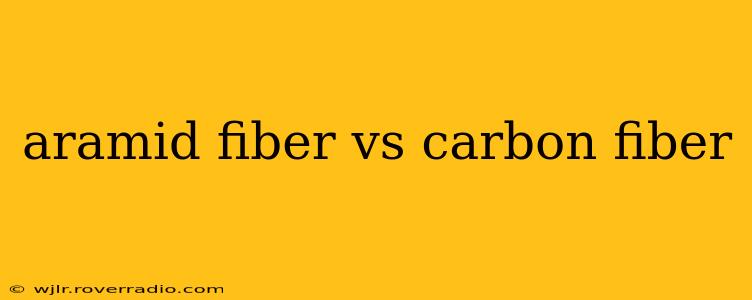Choosing between aramid fiber and carbon fiber often hinges on the specific application. Both are incredibly strong and lightweight materials, but their distinct properties make them better suited for different purposes. This comprehensive guide will delve into the key differences, advantages, and disadvantages of each, helping you understand which material is right for your needs.
What is Aramid Fiber?
Aramid fiber is a synthetic fiber known for its exceptional tensile strength, meaning its resistance to being pulled apart. This strength-to-weight ratio is higher than steel, making it incredibly valuable in applications requiring high strength and low weight. The most common type of aramid fiber is Kevlar®, a brand name synonymous with bulletproof vests and other high-performance protective gear. Other aramid fibers include Nomex® and Twaron®.
Advantages of Aramid Fiber:
- Exceptional Tensile Strength: Aramid fibers boast incredibly high tensile strength, surpassing even steel in some aspects.
- High Impact Resistance: They absorb impact energy effectively, making them ideal for protective applications.
- Good Abrasion Resistance: Aramid fibers are resistant to wear and tear from friction.
- Lightweight: Their low density makes them ideal for applications where weight is a critical factor.
- Chemical Resistance: Aramid fibers are resistant to many chemicals and solvents.
- High Temperature Tolerance (some types): Nomex®, for example, exhibits excellent heat resistance.
Disadvantages of Aramid Fiber:
- Lower Stiffness: Compared to carbon fiber, aramid fiber is less stiff and prone to deformation under compressive loads.
- Susceptibility to UV Degradation: Prolonged exposure to ultraviolet light can weaken aramid fibers.
- Lower Fatigue Resistance: Repeated stress can lead to fatigue and failure more readily than with carbon fiber.
- More Expensive than some other fibers (depending on application): While not always the most expensive option, its cost can be higher than other materials in certain applications.
What is Carbon Fiber?
Carbon fiber is another high-performance material composed of extremely thin carbon filaments bonded together with a resin. It's prized for its exceptionally high strength, stiffness, and lightweight nature. This combination makes it a popular choice in aerospace, automotive, and sporting goods industries.
Advantages of Carbon Fiber:
- High Stiffness: Carbon fiber offers superior stiffness compared to aramid fiber, making it less prone to bending or flexing.
- High Tensile Strength: While comparable to aramid fiber, carbon fiber's strength is combined with superior stiffness.
- Lightweight: Similar to aramid, carbon fiber's low density contributes to its overall performance.
- Excellent Fatigue Resistance: It can withstand repeated stress cycles better than aramid fiber.
- High Modulus: Carbon fiber exhibits a high modulus of elasticity, meaning it resists deformation under load.
Disadvantages of Carbon Fiber:
- Higher Cost: Carbon fiber is generally more expensive than aramid fiber, especially in high-quality grades.
- Brittleness: Carbon fiber can be more brittle than aramid fiber and is more susceptible to damage from impact.
- Difficult to Work With: Manufacturing and shaping carbon fiber composites can be more complex and require specialized equipment.
- Susceptible to Environmental Degradation (in some forms): While generally durable, some formulations can degrade under certain conditions.
Aramid Fiber vs. Carbon Fiber: Key Differences Summarized
| Feature | Aramid Fiber | Carbon Fiber |
|---|---|---|
| Tensile Strength | Very High | Very High |
| Stiffness | Lower | Higher |
| Impact Resistance | High | Lower |
| Fatigue Resistance | Lower | Higher |
| Cost | Relatively Lower (dependent on application) | Higher |
| Brittleness | Less Brittle | More Brittle |
Which Fiber is Right for You?
The choice between aramid and carbon fiber depends heavily on the specific application. Aramid fiber excels in applications requiring high tensile strength, impact resistance, and where cost is a major factor, such as protective gear, ropes, and some composite materials. Carbon fiber shines in applications demanding high stiffness, lightweight construction, and excellent fatigue resistance, including aerospace components, high-performance vehicles, and sporting goods.
What are the typical applications of aramid fiber?
Aramid fiber finds its niche in a variety of applications leveraging its exceptional tensile strength and impact resistance. Common uses include:
- Protective apparel: Bulletproof vests, fire-resistant clothing (Nomex®), and cut-resistant gloves.
- Reinforcement materials: In tires, hoses, and cables, enhancing strength and durability.
- Composites: Used as a reinforcement in various composite materials, offering strength and flexibility.
- Marine applications: Used in ropes, sails, and other marine equipment due to its strength and resistance to saltwater.
What are the typical applications of carbon fiber?
Carbon fiber's high strength-to-weight ratio and stiffness make it ideal for applications demanding high performance and lightweight design. Typical applications include:
- Aerospace: Aircraft components, spacecraft structures, and drone frames.
- Automotive: High-performance car parts, such as body panels, chassis components, and drive shafts.
- Sporting goods: Bicycle frames, fishing rods, tennis rackets, and golf club shafts.
- Wind turbine blades: Contributing to lighter and more efficient wind turbine designs.
- Medical implants: Used in some orthopedic implants and other medical devices.
By carefully weighing the advantages and disadvantages of each fiber, you can make an informed decision for your specific needs. Remember to consider factors like cost, required strength, stiffness, impact resistance, and the environmental conditions the material will face.
